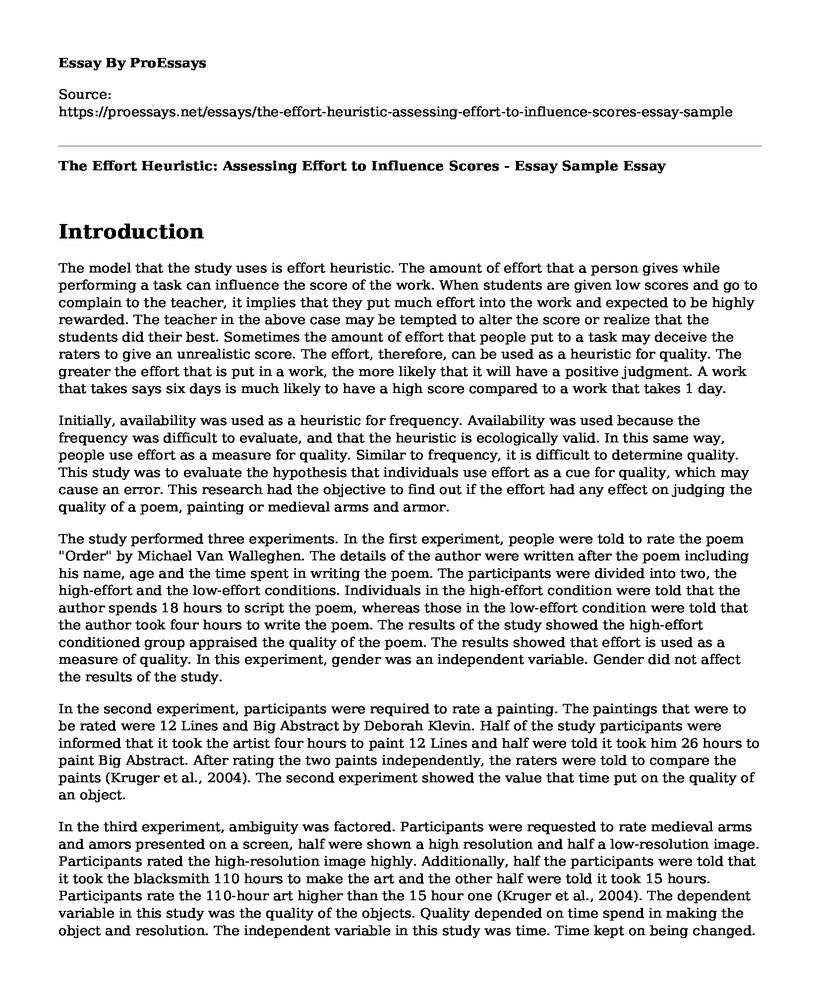Introduction
The model that the study uses is effort heuristic. The amount of effort that a person gives while performing a task can influence the score of the work. When students are given low scores and go to complain to the teacher, it implies that they put much effort into the work and expected to be highly rewarded. The teacher in the above case may be tempted to alter the score or realize that the students did their best. Sometimes the amount of effort that people put to a task may deceive the raters to give an unrealistic score. The effort, therefore, can be used as a heuristic for quality. The greater the effort that is put in a work, the more likely that it will have a positive judgment. A work that takes says six days is much likely to have a high score compared to a work that takes 1 day.
Initially, availability was used as a heuristic for frequency. Availability was used because the frequency was difficult to evaluate, and that the heuristic is ecologically valid. In this same way, people use effort as a measure for quality. Similar to frequency, it is difficult to determine quality. This study was to evaluate the hypothesis that individuals use effort as a cue for quality, which may cause an error. This research had the objective to find out if the effort had any effect on judging the quality of a poem, painting or medieval arms and armor.
The study performed three experiments. In the first experiment, people were told to rate the poem "Order" by Michael Van Walleghen. The details of the author were written after the poem including his name, age and the time spent in writing the poem. The participants were divided into two, the high-effort and the low-effort conditions. Individuals in the high-effort condition were told that the author spends 18 hours to script the poem, whereas those in the low-effort condition were told that the author took four hours to write the poem. The results of the study showed the high-effort conditioned group appraised the quality of the poem. The results showed that effort is used as a measure of quality. In this experiment, gender was an independent variable. Gender did not affect the results of the study.
In the second experiment, participants were required to rate a painting. The paintings that were to be rated were 12 Lines and Big Abstract by Deborah Klevin. Half of the study participants were informed that it took the artist four hours to paint 12 Lines and half were told it took him 26 hours to paint Big Abstract. After rating the two paints independently, the raters were told to compare the paints (Kruger et al., 2004). The second experiment showed the value that time put on the quality of an object.
In the third experiment, ambiguity was factored. Participants were requested to rate medieval arms and amors presented on a screen, half were shown a high resolution and half a low-resolution image. Participants rated the high-resolution image highly. Additionally, half the participants were told that it took the blacksmith 110 hours to make the art and the other half were told it took 15 hours. Participants rate the 110-hour art higher than the 15 hour one (Kruger et al., 2004). The dependent variable in this study was the quality of the objects. Quality depended on time spend in making the object and resolution. The independent variable in this study was time. Time kept on being changed.
The COVID19 pandemic will affect the experiment in several ways. The pandemic has caused the government to call off public gatherings. This means that getting participants at a central place will be difficult. The research will now entail moving from one person to the other separately. The pandemic has caused fear in people making them unwilling to interact with strangers. The fear will make it somewhat impossible for people to enter the study willingly. The movement will also increase the budget of the study.
References
Kruger, J., Wirtz, D., Van Boven, L., & Altermatt, T. W. (2004). The effort heuristic. Journal of Experimental Social Psychology, 40(1), 91-98.
Cite this page
The Effort Heuristic: Assessing Effort to Influence Scores - Essay Sample. (2023, May 18). Retrieved from https://proessays.net/essays/the-effort-heuristic-assessing-effort-to-influence-scores-essay-sample
If you are the original author of this essay and no longer wish to have it published on the ProEssays website, please click below to request its removal:
- My Own Personal Theory of Human Learning and Development Essay
- Educator Preparation Reflection Essay
- Malignant Transformation of Recurrent Nasopharyngeal Angiofibroma in Elderly Male: Case Study
- Paper Example on Attracting, Retaining, & Training Nurses in Rural Areas: An Evaluation
- Marijuana: Adverse Effects Despite Potential Benefits - Essay Sample
- Essay Example on UWB Health Studies Student: Dedicated to Helping the Sick
- Essay Example on Joint Commission: Socio-Technical Systems in Non-Profit Organizations







